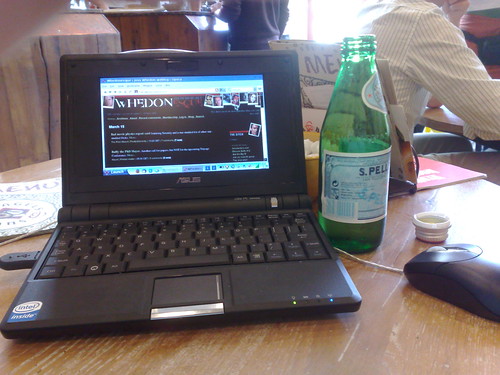Now that I have had my Asus EEE for a week and have taken it for a test run in the field I think it’s time to jot down some thoughts.
The EEE pc is one of the most satisfying buys ever. It weighs nothing. I don’t even feel I’m carrying it. Despite that, it doesn’t look cheap or feel like a toy. (I can’t vouch for the other colours, but the black version looks like an ordinary laptop. Just a lot smaller.) There’s no reason not to pop it into my bag and take it everywhere I go.
It works (after plugging it in and/or charging it) out of the box, starts up in 10 to 15 seconds, has a preinstalled interface that anyone can understand, comes with oodles of software including games, an open source office suite, Firefox, Thunderbird, excellent WiFi, a photo viewer/slideshow, screen capture, a news reader, IM client, Skype, etc, etc.
While I’m not completely new to Linux, I’m not that familiar with it either. I use *nix commands on the server that hosts my sites, but my home and work desktop PCs have always run Windows or a Mac OS. So I don’t know much about the various incarnations of Linux.
The EEE runs a custom Asus version of Xandros by default. Once I switched from the ‘Easy’ desktop environment to Advanced it looks a lot like a rip off of Windows XP – which is almost disappointing. It’s not the most exciting look. But I didn’t know Linux GUI’s were this advanced. I thought there’d be more command line stuff to get to grips with, but you get lots of menus and right click options, just like in XP. Again… that’s almost disappointing. I guess that’s why they called it “EEE, Easy to learn, work and play”.
The trackpad does the job, but isn’t great for prolonged usage. It is small and the left and right click button feels a little stiff. I plugged in an old mouse which worked really well, so I bought a nice small notebook mouse from Microsoft which works even better. The keyboard could have been better too. I have to hit the space bar pretty hard to make it work and I find touch typing difficult in any other position than seated at a desk.
I mentioned switching to the Advanced desktop. Out of the box, the EEE starts up with an ‘Easy’ interface, which is just a couple of tabs with large icons on it. If you want to get the most out of the machine, use the Advanced desktop. It used to be an option on the menu, but Asus decided to market the machine as an appliance rather than a pc, so they took the option out. You have to put it back in. It’s pretty easy to do, following these instructions: ‘Enable Advanced Desktop mode‘ from the eeeuser.com wiki. Note that personalising the EEE environment almost always involves opening a terminal window and doing some command line stuff. So stick to Easy mode if that scares you.
The EEE can play quite a few different video formats, even .mkv files, although there were some synch problems with the file I tried. What the EEE can’t do is play the ipod compatible formats, mp4/quicktime h.264. But no worries, if you downgrade the supplied mplayer, it will play those as well.
Firefox is preinstalled but the browser’s chrome will dominate a large part of the tiny screen. You’ll have to fiddle with settings a bit to make better use of your real estate. In fact, Opera seems to be the better choice, especially if you use that browser’s fit-to-width option. You’ll have to install Opera and then customise it following instructions from the the eeeuser.com wiki to make the most of the space you have.
To make your EEE a portable jukebox, ideally you’d want to install a bittorrent client, but I haven’t got round to that. I tried a Firefox torrent extension, but could not get it to work. For now I’ve settled for a Limewire clone called Frostwire. I’m not a big fan of the Gnutella protocol, since I prefer the high quality rips found elsewhere, but it will have to do for now.
Wrapping up this review, the Asus EEE is a fantastic little computer. If you get one, spend some time customising it with help from the EEE user community. Buy a small mouse. You’ll need at least some extra storage so one or two SD cards will come in handy, and/or a USB flash stick. And remember, if your system dies while you’re customising it, you can easily revert to factory settings by hitting F9 during start up.
Photographers should consider this set up for a great portable storage and post-processing solution.























